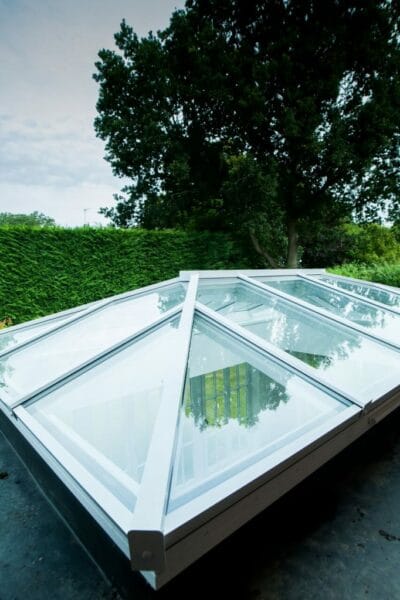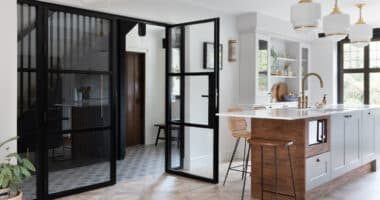Choosing a roof lantern is actually not a complicated process once you understand how similar most lantern roofs are. As a result, you can focus your buying decision based on styling, price and the company you want to use. Our buying guide to choosing a roof lantern explains more about the product, what to look for and the benefits you get.
Choosing a roof lantern – why they transform any room
Any roof lantern brings in significant light compared to a regular window or door. And this is where choosing a roof lantern for your new extension or even an existing flat roof transforms a space with an immediate difference to the feel of the room. Few products create a brighter more spacious environment and one that is great to sit in at any time of year but especially during the winter.
By far the benefit of a lantern roof or even a rooflight is how the light comes from above and brightens up even alcoves, corners or areas of the room the windows and doors may not reach.
Even better, choosing a roof lantern lets you turn your lights on later during the winter months as well as creating added warmth and helping reduce your energy bills.
But these clever design features are so much more than practical problem-solvers. Roof lanterns add a real touch of design magic to your home, giving a dash of drama to dining rooms, adding uninterrupted overhead views of the starry skies at night and making your home look stunning from the outside, too.
Are roof lanterns worth it?
There’s no question assuming budget allows it, that any rooflight creates an altogether better room. And they’re a terrific complement to any window or patio door set below it. Yes, lantern roofs are worth it for the additional light from many angles and the feeling of space they create. They’re most popular in kitchen and living space extensions, also just as good in any other room.
- rooms feel bigger and brighter
- roof lanterns alter the room dimensions and increase your ceiling height
- a visually appealing focal point that adds appeal to any property and value
When choosing a roof lantern, you also have peace of mind that they’re energy-efficient, they don’t make the room feel cold and don’t lose heat. In many typical refurbishments, they don’t need planning permission either.
Skylight vs Rooflight vs Lantern – what’s the difference?
Skylights and rooflights are names given to any ‘window’ in the roof but typically these are flat or pitched, fixed or opening windows set to follow the roof angle.
A lantern roof raises above the roofline in a pyramid, rectangular or square box shape. They’re also more visible than flat rooflights and skylights. The benefit of the pyramid design is light comes in from more angles than a flat skylight.
Skylights and rooflights are less visible and prominent. When viewed internally, most models appear frameless. , lantern roofs, given their increased height and different look are more visible and evident.
What’s the right material when choosing a roof lantern?
Whilst aluminium lantern roofs are the slimmest and the most desirable, you should also consider alternative materials such as PVCu and timber.
The benefits of aluminium over other materials are well known. Slim lines, colour choice and reduced weight with excellent strength. However, lantern roofs are simple products, despite the marketing messages and actually quite basic in design compared with the more advanced requirements and construction of a door or a window. This overall much simpler product makes other materials equally worthy of consideration. You’re not compromising by considering timber or PVCu. In fact, they’re mostly engineered in exactly the same way.
So if you want a PVCu lantern roof because they’re the cheapest and it helps keep the budget down, go see them. You won’t get a significantly different product to an aluminium, timber or one using a combination of materials. All reputable lantern roofs regardless of material are safe, secure, weather-resistant and built to last. The current range of PVCu, timber or hybrid lanterns is slimmer, more energy-efficient and better-built than ever.


Things to consider before buying a roof light
First of all, it’s worth thinking about which way the room faces. South-facing rooms risk getting too much sun and being too hot to sit in as a result. North facing rooms obviously benefit from the added light and here you may want a larger roof lantern than on other elevations.
The size of your roof lantern is also important. Whilst it’s tempting to go big, this can look out of place on a typical extension or even a little ostentatious. Often one 3m long lantern is ample for most property renovations and of course, you could consider smaller lanterns side by side.
Your next choice is whether you prefer a traditional or contemporary style. Whilst the arrangement may look the same, there are slight differences. Contemporary roofs have slimmer flatter profiles and fewer bars. Traditional lanterns feature more moulded profiles and may even come with options for more decorative pieces – crests, finials etc at the top. They look more classic.
Internally, traditional and contemporary roof lanterns don’t look too different. It’s usually a flat profile inside for the modern version or a more rounded timber-like look inside for the traditional.
When choosing a roof lantern, beware of the many claims made by rooflight manufacturers regarding interior comfort. Glass is glass and whilst there is excellent solar control glass on the market, no glass as far as we are aware totally eliminates heat coming into your room although they can reduce it to quite comfortable levels. There is always a compromise with so much glass. Therefore, be realistic that some rooms may get warm having a lantern roof above and especially with large patio doors below.
How lantern roofs are all very similar
Then it comes to deciding which roof brand is the best. With many lantern roofs all boasting something unique, the truth is they’re all very similar.
The quality of the aluminium profiles used the glass, seals and gaskets and the powder-coated finish. All of these component parts are of near-identical quality and type. Why? It’s because long-established industry standards dictate the quality of many key components.
Some of the prominent messages you’ll see when choosing a roof lantern are about fast and easy assembly and installation. How easy the installation of a product is, rarely concerns end-users. But by all means, take notice of this if it matters or if you’re buying choosing a roof lantern on a supply basis for your builder to fit.
Then we come to the sealing and design of the overall product. The reality is they’re all very similar using similar design and engineering principles for sealing the roof or letting any water drain safely away.
With so many similarities, you can therefore focus on aesthetics such as slim lines, fewer support bars and the overall appearance. Also focus also on getting an attractive price and an installation company you trust and want to do business with. You can get in touch and we can help with this too.
What glass is best when buying a new lantern roof?
When choosing a roof lantern, you can expect safety glass as standard. Most suppliers provide toughened glass to the outside pane and laminated glass to the inside pane.
Laminated glass is best described as like a car windscreen. In the event that it breaks, it’ll crack but hold together. Toughened glass is like the side windows in a car. It’s also incredibly strong, but should it break instead shatters into many small blunt pieces. Then as a standard glass type, you should expect a soft-coat low-emissivity coating, warm edge spacer bars and argon gas fill.
The glass you choose will play a huge role in the comfort of the room. Triple glazing is an option and no doubt provides the best in acoustics and thermal performance. That said, high specification double glazed units come close to the performance of triple glazing, depending on their make up. If energy efficiency matters go for the best insulated glass available. A good installer can tell you the various types they offer.
You then have a choice of solar control and self-cleaning glass and both of these options are recommended either individually or together.
Understanding what roof lantern U-Values mean
A U-Value measures how well any window, door or roof stops heat from escaping. The lower the U-Value, the better the thermal performance and insulation.
For modern glazing and meeting Building Regulations, there are two commonly quoted U-value measurements.
Centre pane U-values are calculated through the middle of a pane of glass, hence ‘centre’ pane. Importantly, centre pane U-Values disregard the edge of the glass units as well as the frame itself, whether PVCu, aluminium or timber. It’s all about the U-Value in the middle of the glass unit.
Window U-values differ because they calculate the U-Value as a whole window including the frame, the sealant and the spacer bar making up a glass unit. The whole window U-Value is usually the better one as you obviously want other elements of a window to matter in the performance.
Study the stated U-Values carefully in the marketing materials and you’ll frequently see the centre pane U-Value quoted. So where one lantern roof may appear more thermally efficient with a lower U-Value, another brand with higher performance glass would beat it. The takeaway here is whilst thermal performance is important, pretty much all products come with already high-performance glass. There’s little difference in real terms between a better 1.3 U-Value compared with a 1.6 U-Value.
Do you need planning permission for a lantern roof?
In most cases, Permitted Development rules apply.
It’s worth bearing in mind your lantern roof must not extend 150mm above the existing roof plane and no higher than the highest part of the roof. You’ll find rules around lantern roofs on the side of the house needing obscure or privacy glass as well as restrictions on minimum heights for opening roofs.
Some parts of the UK have more conservation areas than others so always seek professional advice and your local planning authority.
Latest articles
- the flush door Threshold. Accessibility, Safety, Style July 27, 2024
- Spitfire S-500 vs Glasswin doors – which is better? November 29, 2023
- Revealing the Leading Slimline Aluminium Windows August 7, 2023
- Aluco floating lock – the slimmest aluminium doors August 1, 2023
- The complete guide to reynaers aluminium windows July 19, 2023
















